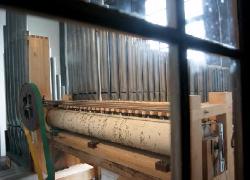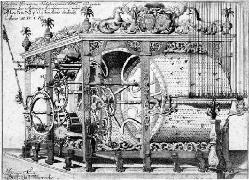| A Little Background Music |
| Archbishop Pilgrim II from Puchheim (reigned from 1365-1396) was the first archbishop to actively sponsor music and composition, and from the 15th century on, music at the fortress Hohensalzburg drifted down from on high and greeted everyone from the wealthy patrician to the beggar in rags. Salzburg employed a number of eminent composers through the centuries, among them Heinrich Finck, Paul Hofhaimer, Heinrich Biber, Georg Muffat, Johann Ernst Eberlin, Giuseppe Francesco Lolli and later of course, Leopold Mozart and later his son Wolfgang. The composition and performance of cathedral music was the principal mission of court musicians. Positions included a Kapellmeister, a vice-Kapellmeister, composers and several instrumentalists (violinists, viola players, cellists, double bassists, keyboard players, oboists, flautists, bassoonists, horn players, trombonist and more). There were then the singers and the choir, all sometimes constituting over a hundred performers in total. There were two high trumpet towers in the Hohensalzburg erected in 1465 and 1506 from which there was a spectacular view of the surrounding countryside. At night, a huge lantern was hung from the upper tower and during the day a flag. When people approached the fortress, they were spotted from the towers and announced with horns and trumpets which signalled the soldiers in the fortress as well as the townsfolk below of approaching friends or foe. Hence, visitors to Salzburg describe the deafening roar of gun salvos, trumpets and drums heralding their approach mixed with the heavenly sounds of concerts in progress. The royal trumpeters also played to entertain, not only from the trumpet towers, but at the court, in front of the Rathaus, at the church and the convent and in front of the houses of the elite, all for a reward of coins, while members of the Salzburg court orchestra played the music of the greats in the grand rooms and chambers of the Salzburg court and at festivals and celebrations. St George's chapel at the fortress Hohensalzburg in Salzburg was built during the reign of Archbishop Leonard von Keutschach (1495 to 1519) and inaugurated on August 21, 1502. Although during the Middle ages, many towns, cities, monasteries and cloisters had mechanical organs built into their gates and towers, the only organ to have survived in its entirety until today is the so-called “castle horn” organ (pictured at the top of page) at Hohensalzburg (Salzburger Stier), the organ which von Keutschach had built in order to communicate with the inhabitants of the town in a method akin to the use of alpine horns in the valleys. The “castle horn” woke the townsfolk up at 4AM and signaled their bedtime at 7PM. It also reminded everyone of the Archbishop's power over them. Apart from the Salzburger Stier, Salzburg has a rare abundance of other unique sound monuments. Construction of the Neue Residenz in Salzburg took place at the end of the 16th Century by Prince Archbishop Wolf Dietrich von Raitenau and additional wings were erected by two other bishops. Archbishop Johann Ernst Graf Thun decided the joint needed a "juke box", and the self-playing Salzburger Glockenspiel, an apparatus with a complicated mechanism of wheels, bearings, pulleys, springs, rods, shafts and screws was born. The archbishop bought 35 bells in 1695 from bell caster Melchior de Haze in Antwerp. Its gamut ranges over three octaves with all semitones. Salzburg gunsmith Franz Sulzer and bell caster Benedikt Eisenberger made the drive mechanism and the man-sized brass roller drum in 1702, into which court clockmaker Jeremias Sauter drilled the 7,964 holes with required for operation along with 35 different covers with a double hammering notes for each melody specially set. The Glockenspiel has been playing music since 1704, and now includes around 40 pieces, of which 16 are ascribed to Johann Michael Haydn, as well as musical pieces by the Mozarts, adaptations from the nineteenth century. The Salzburg Glockenspiel was recently completely restored and can be heard daily at 7 am, 11 am and 6 pm. Common folks living in the country, meanwhile, enjoyed their own sound of music. The songs of the Salzburg area farmers and especially the salt miners was not as formal, but was still an integral part of their lives. Their songs expressed the daily threat of danger, but also joy in their work. Numerous folksongs and tales from the various mining regions resounded through the ages as well, many of which have long since vanished from memory. The mountainfolk always sang and danced, making music out of easily available implements. In the country, musical instruments included the goat’s horn, alphorn, willow pipe, jingle bells, whips, thunder sticks and a stick and chain. Other objects joined in the merry making, such as aged brass instruments, pans and pot lids and violin-dulcimers or Hackbretts. Similar to a hammered dulcimer, the German Hackbrett evolved from the string drum early in the 15th century which was said to have originated long before in Persia. It was a rectangular instrument strung with metal strings and struck with two hammers. Also used were harps, zithers, fiddles and (later) hurdy-gurdys and accordions. It is recorded that throughout the alpine regions, song was heard everywhere, from the farmhands singing while doing their chores to impish boys singing bawdy songs in the village. Dancing was equally as popular whenever allowed and many an inn in the major towns had its own dance hall even in the 15th century, and theater halls served as dance halls in the 16th and 17th centuries in some areas. Even schools and parsonages were sometimes put to use as dance halls. Under Duke Sigmund and Emperor Maximilian, royal guests enjoyed the dance, and some heads of government actually encouraged the burghers to dance in the 16th century. But dances were sometimes boisterous on such occasions as church dedication days, and were often stopped at the instigation of Jesuit missions. In January, 1663 the Bishop of Trent prohibited dances in general in a decree that threatened to punish anyone, including the musicians, who went to a ball. Before becoming Archbishop of Salzburg, Bishop Leopold Firmian vehemently attempted to curtail the much loved dancing in the early 18th century. None of the bans, however, stopped young people from dancing on mountain meadows. |
| THE SALZBURGERS |
| Above left: the "Salzburg Stier" barrel organ from 1502 is the last example of Gothic organ construction to survive and the oldest automated musical instrument played daily in the world. Right: Engravings by Christoph Lederwasch of the Salzburger Glockenspiel (click) |

